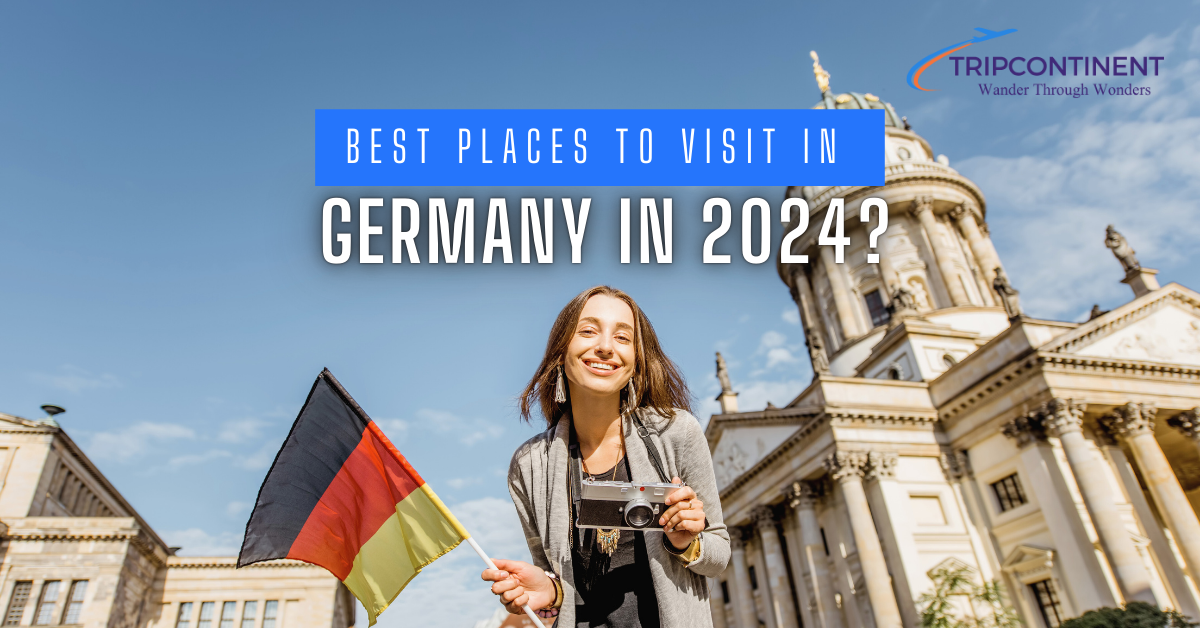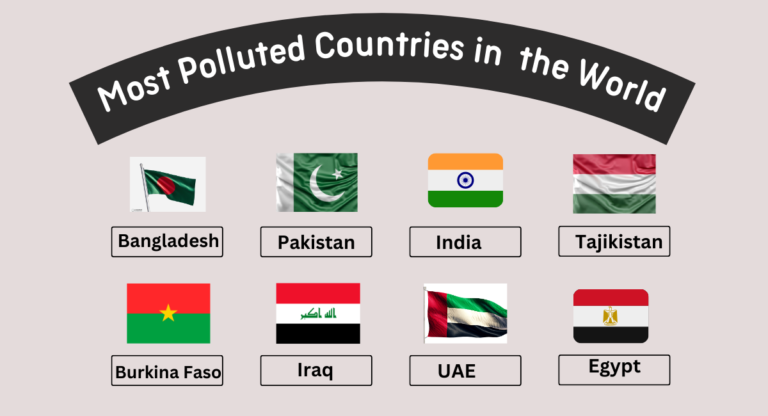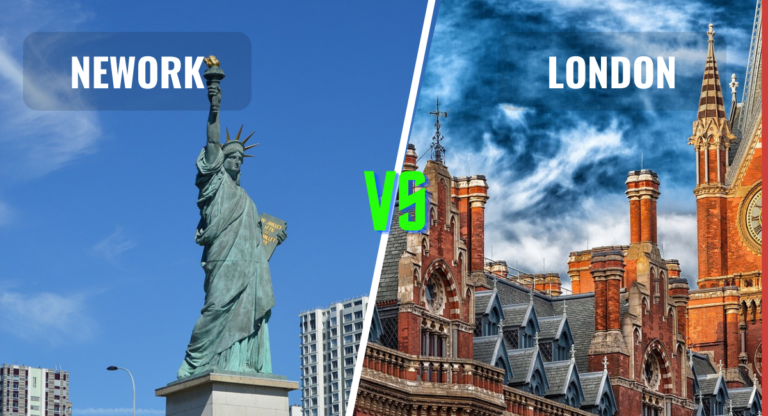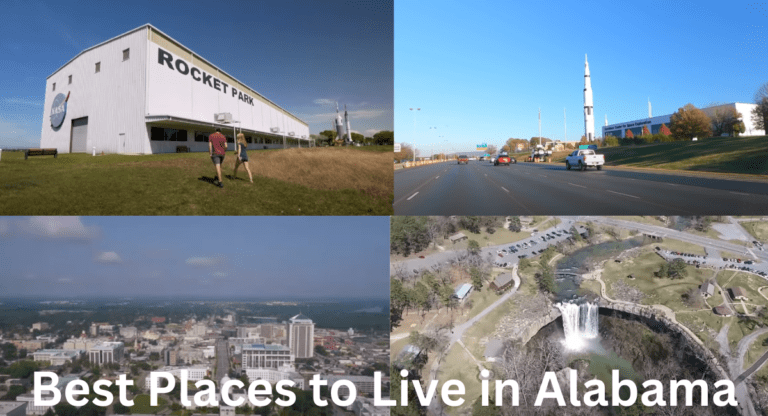Which Are the Best Places to Visit in Germany in 2024?
Germany is rich in history, culture, and natural beauty, offering various attractions for every type of traveler. From bustling cities with vibrant art scenes to picturesque villages nestled in scenic landscapes, Germany has something for everyone.
Germany’s blend of historical depth, cultural richness, and natural beauty makes it an ideal destination for any traveler seeking an unforgettable European adventure. Let’s explore the Best Places to Visit in Germany in this blog.
List of the Best Places to Visit in Germany
The following is the list of the Best Places to Visit in Germany.
- Museum Island
- The Berlin Wall
- Cologne Cathedral
- The Rhine
- Miniatur Wunderland
- St. Michael’s Church
- Marienplatz
- Frauenkirche
- The Island Of Rügen
- Berlin Zoological Garden
- Heide Park Resort
1. Museum Island
Museum Island, located in the heart of Berlin, Germany, is a remarkable cultural and historical treasure. This UNESCO World Heritage site is situated on the northern half of an island in the Spree River and is home to five of Berlin’s most significant museums. The island’s origins date back to the early 19th century when King Friedrich Wilhelm III commissioned the first museum, now known as the Altes Museum.
The Altes Museum, completed in 1830, is renowned for its classical architecture and houses a vast collection of antiquities, including Greek, Roman, and Etruscan artifacts. Adjacent to it is the Neues Museum, which reopened in 2009 after extensive restoration. It showcases Egyptian and prehistoric collections, most notably the iconic bust of Nefertiti.
The Alte Nationalgalerie, or Old National Gallery, offers an impressive array of 19th-century art, featuring works by famous German artists such as Caspar David Friedrich and Adolph Menzel. This museum provides a fascinating glimpse into the Romantic and Impressionist movements.
The Bode Museum, located at the island’s northern tip, is distinguished by its exquisite Baroque architecture. It hosts a stunning collection of Byzantine art, coins, and medals, as well as European sculptures from the medieval period to the 18th century.
Finally, the Pergamon Museum is perhaps the most famous of all, renowned for its monumental reconstructions of ancient structures. Visitors can marvel at the Pergamon Altar, the Market Gate of Miletus, and the Ishtar Gate of Babylon. The museum’s extensive collection of Middle Eastern art and Islamic art is also a major draw.
Also Read: Most Peaceful Countries in the World
2. The Berlin Wall
The Berlin Wall, a powerful symbol of the Cold War, divided East and West Berlin from 1961 to 1989. Erected by the German Democratic Republic (GDR), the Wall was intended to prevent East Germans from fleeing to the democratic West. Stretching approximately 155 kilometers (96 miles), the Wall was a formidable barrier, complete with guard towers, anti-vehicle trenches, and a “death strip” that deterred escape attempts.
Construction of the Berlin Wall began on August 13, 1961, transforming the city overnight. Families were separated, and East Berliners found themselves cut off from their jobs, schools, and social connections in the West. The Wall was a stark representation of the “Iron Curtain” that separated Eastern and Western Europe during the Cold War.
One of the most poignant sites to visit today is the East Side Gallery, a 1.3-kilometer (0.8-mile) section of the Wall adorned with over 100 murals painted by artists from around the world. This open-air gallery stands as a testament to the spirit of freedom and creativity that emerged after the Wall’s fall. Notable artworks include the iconic “Fraternal Kiss” by Dmitri Vrubel and “Test the Best” by Birgit Kinder.
The Berlin Wall Memorial on Bernauer Strasse provides a comprehensive look at the Wall’s history. The memorial includes a preserved section of the Wall, a documentation center, and an outdoor exhibition that tells the stories of those who lived in its shadow. Visitors can also see the Chapel of Reconciliation, which stands on the former “death strip” and serves as a place of reflection and remembrance.
Checkpoint Charlie, one of the most famous border crossings between East and West Berlin, is another must-visit site. The checkpoint now hosts a museum detailing escape attempts, Cold War espionage, and the Wall’s impact on global politics.
3. Cologne Cathedral
Cologne Cathedral, or Kölner Dom, is one of Germany’s most iconic landmarks and a masterpiece of Gothic architecture. Located in the heart of Cologne, this UNESCO World Heritage site stands as a testament to medieval craftsmanship and religious devotion. Construction of the cathedral began in 1248 but was not completed until 1880, a span of over 600 years.
The cathedral’s twin spires, each soaring to a height of 157 meters (515 feet), dominated the city skyline and were the tallest structures in the world until the completion of the Washington Monument in 1884. Visitors are often struck by the grandeur and intricacy of the façade, which features a wealth of statues, gargoyles, and elaborate carvings.
Inside, the cathedral is equally impressive. The soaring nave, measuring 144 meters (472 feet) long and 43 meters (141 feet) high, creates an awe-inspiring sense of space. The stained glass windows, particularly the modern “Richter Window” designed by artist Gerhard Richter, are a highlight, bathing the interior in a kaleidoscope of colors. The windows date back to various periods, with some medieval originals and others from the 19th and 20th centuries.
One of the cathedral’s most treasured relics is the Shrine of the Three Kings, an elaborate gilded sarcophagus believed to hold the remains of the Three Wise Men. This magnificent artifact attracts pilgrims from around the world. Another notable feature is the Gero Cross, one of the oldest surviving large-scale crucifixes in Europe, dating back to around 970 AD.
For those with a head for heights, climbing the 533 steps to the top of the South Tower offers breathtaking views of Cologne and the Rhine River. The effort is well worth it, providing a unique perspective on the cathedral’s architecture and the city below.
4. The Rhine
The Rhine River, one of Europe’s most significant and picturesque waterways, flows from the Swiss Alps through Germany and the Netherlands, before emptying into the North Sea. Spanning approximately 1,230 kilometers (760 miles), the Rhine has been a crucial artery for commerce, culture, and travel for centuries.
The Rhine’s journey begins in the Swiss canton of Graubünden, where it flows north through Lake Constance and forms part of the border between Switzerland and Germany. It then meanders through Germany, passing cities such as Basel, Strasbourg, and Cologne, before reaching the Netherlands.
One of the most enchanting sections of the Rhine is the Middle Rhine Valley, a UNESCO World Heritage site known for its stunning landscapes and historic castles. This 65-kilometer (40-mile) stretch between the towns of Bingen and Koblenz is often referred to as the Rhine Gorge. Steep vineyards, picturesque villages, and over 40 medieval castles and fortresses line the riverbanks, creating a fairy-tale setting. Highlights include the Lorelei Rock, a steep slate cliff associated with legends of a siren luring sailors to their doom, and the Marksburg Castle, one of the best-preserved castles in the region.
For travelers, the Rhine offers a variety of experiences. River cruises are a popular way to explore its beauty, providing a leisurely journey through the scenic heart of Europe.
The Rhine is also vital to the economic life of the region, serving as a major shipping route for goods. Ports along the river, such as those in Rotterdam and Duisburg, are among the busiest in Europe, facilitating the movement of everything from raw materials to finished products.
Culturally, the Rhine has inspired countless artists, poets, and composers over the centuries. Its romantic landscapes and historical significance have been celebrated in works by figures such as Richard Wagner and Heinrich Heine.
You might also like: Safest Cities in Europe
5. Miniatur Wunderland
Miniatur Wunderland, located in Hamburg, Germany, is the world’s largest model railway exhibition and a marvel of miniature engineering and artistry. Opened in 2001, this incredible attraction has become a must-visit destination for enthusiasts of all ages, drawing millions of visitors annually.
Covering an expansive area of over 1,500 square meters (16,000 square feet), Miniatur Wunderland features meticulously detailed replicas of various regions from around the world. The exhibit includes over 15 kilometers (9 miles) of track and more than 1,000 trains, making it a mesmerizing spectacle of motion and light. Each section is crafted with astonishing accuracy and attention to detail, from the bustling streets of Hamburg to the serene landscapes of the Swiss Alps.
One of the standout areas is the Hamburg section, which captures the essence of the city with miniaturized versions of its iconic landmarks, including the Elbphilharmonie concert hall and the St. Michael’s Church. Another highlight is the Alps section, showcasing breathtaking mountain scenery, winding train routes, and charming alpine villages. Visitors can also explore the USA section, featuring Las Vegas with its vibrant lights, the Grand Canyon, and even the bustling streets of Miami.
The latest addition to Miniatur Wunderland is the stunning Venice section, which took three years to complete. This meticulously crafted area includes over 280 buildings, 30 gondolas, and a working replica of the famous St. Mark’s Basilica.
Miniatur Wunderland also features an airport section, complete with planes taking off and landing, a marvel of miniature engineering. The attention to detail extends to the day and night cycles, with over 500,000 LED lights creating realistic lighting effects.
Traveling to Miniatur Wunderland is easy, as it is located in the historic Speicherstadt district of Hamburg, a UNESCO World Heritage site.
6. Michael’s Church
St. Michael’s Church, locally known as “Michel,” is one of Hamburg’s most iconic landmarks and an outstanding example of Baroque architecture in northern Germany. This Protestant church has a rich history and offers visitors a blend of spiritual significance, historical depth, and architectural grandeur.
The original St. Michael’s Church was constructed between 1647 and 1669, but it suffered significant damage due to lightning strikes and fires over the centuries. The current structure, completed in 1786, is the third church built on this site. It features an impressive facade and a distinctive copper-covered spire that rises 132 meters (433 feet) high, making it a prominent feature of Hamburg’s skyline.
Inside, the church’s interior is as impressive as its exterior. The nave, with its white and gold decor, can accommodate around 2,500 worshippers. The magnificent altar, adorned with intricate carvings and sculptures, is a focal point, and the large organ, with over 6,000 pipes, adds to the church’s grandeur. The acoustics of the church are exceptional, and it regularly hosts concerts and musical events that draw audiences from near and far.
One of the highlights of a visit to St. Michael’s Church is the opportunity to climb the tower. After ascending the 452 steps (or taking the elevator), visitors are rewarded with a breathtaking panoramic view of Hamburg, the harbor, and the surrounding areas. On clear days, the view extends as far as the North Sea.
The church also houses a crypt where notable figures from Hamburg’s history are buried. The crypt is open to the public and provides a fascinating glimpse into the city’s past.
7. Marienplatz
Marienplatz, located in the heart of Munich, Germany, is one of the city’s most famous and vibrant squares. Serving as the main square since 1158, Marienplatz is steeped in history and brims with architectural marvels, cultural activities, and bustling energy, making it a must-visit destination for travelers.
At the center of Marienplatz stands the Mariensäule, or Mary’s Column, erected in 1638 to celebrate the end of Swedish occupation during the Thirty Years’ War. Topped with a golden statue of the Virgin Mary, this column is a significant historical and religious landmark.
The New Town Hall (Neues Rathaus), an impressive neo-Gothic building constructed between 1867 and 1908, dominates the square. Its intricate façade and soaring towers are architectural highlights. The Rathaus-Glockenspiel, located in the tower of the New Town Hall, is a major attraction. Every day at 11 a.m. (and also at noon and 5 p.m. in summer), the Glockenspiel’s 43 bells and 32 life-sized figures reenact historical Bavarian events, captivating crowds with its charming and elaborate performance.
Opposite the New Town Hall is the Old Town Hall (Altes Rathaus), a striking Gothic structure that dates back to the 14th century. Though it was rebuilt after World War II, it retains its historical charm and now houses a toy museum that showcases a delightful collection of antique toys.
Marienplatz is also a hub for shopping and dining. The pedestrian zones around the square are lined with shops, boutiques, and department stores offering everything from high-end fashion to traditional Bavarian crafts. For a taste of local cuisine, visitors can enjoy hearty Bavarian dishes at nearby beer halls and restaurants, or savor sweet treats at quaint cafés.
Marienplatz is also a hub for shopping and dining. During the Christmas season, Marienplatz transforms into a winter wonderland with its famous Christmas market, or Christkindlmarkt.
Also explore: Most Traded Currencies in the World
8. Frauenkirche
The Frauenkirche, officially known as the Cathedral of Our Dear Lady (Dom zu Unserer Lieben Frau), is one of Munich’s most iconic landmarks. This Gothic-style church, with its distinctive twin towers topped with onion domes, dominates the city’s skyline and holds significant historical, architectural, and cultural importance.
Construction of the Frauenkirche began in 1468 under the direction of Jörg von Halsbach, and it was completed in 1488. The church was built on the site of an older church, and its construction was partly funded by a letter of indulgence issued by Pope Sixtus IV. The brick structure measures 109 meters (358 feet) in length and 40 meters (131 feet) in width, making it one of the largest Gothic churches in southern Germany.
One of the most striking features of the Frauenkirche is its twin towers, each standing 99 meters (325 feet) tall. The towers were completed in 1525, and the unique onion domes were added in the 16th century. These domes have become a defining feature of Munich’s skyline and a symbol of the city.
Inside, the Frauenkirche is spacious and austere, with a capacity to hold around 20,000 people. The interior features impressive Gothic vaulting and several notable artworks, including the altarpiece depicting the Assumption of the Virgin Mary and the tomb of Emperor Ludwig IV of Bavaria, a magnificent bronze monument crafted by Hans Krumpper.
One of the intriguing legends associated with the Frauenkirche is the “Devil’s Footprint” (Teufelstritt), a black mark on the floor near the entrance. According to legend, the devil made this footprint when he visited the church and was tricked by the architect into thinking the church had no windows. When the devil realized he had been deceived, he stamped his foot in anger, leaving a mark that can still be seen today.
The Frauenkirche also plays a vital role in the religious life of Munich. It serves as the cathedral for the Archdiocese of Munich and Freising and is the seat of the Archbishop of Munich, a position once held by Cardinal Joseph Ratzinger, who later became Pope Benedict XVI.
For travelers, visiting the Frauenkirche offers a glimpse into Munich’s rich history and architectural heritage. The church is located in the city center, just a short walk from Marienplatz, making it easily accessible.
9. The Island Of Rügen
The Island of Rügen, located in the Baltic Sea off the northeastern coast of Germany, is the largest island in the country and a popular travel destination known for its natural beauty, charming seaside resorts, and rich history. Part of the state of Mecklenburg-Vorpommern, Rügen offers a diverse range of attractions for nature lovers, history buffs, and leisure seekers.
Rügen’s landscape is characterized by its stunning chalk cliffs, particularly those found in the Jasmund National Park. The most famous of these cliffs is the Königsstuhl, or King’s Chair, which stands 118 meters (387 feet) high and offers breathtaking views of the Baltic Sea. The park, a UNESCO World Heritage site, is crisscrossed with hiking trails that allow visitors to explore its ancient beech forests, diverse flora and fauna, and scenic coastal vistas.
The island is also home to several picturesque seaside resorts, the most notable being Binz, Sellin, and Göhren. Binz, with its elegant villas and a beautiful sandy beach, is the largest and one of the most popular resorts. Its historic pier, the Seebrücke Binz, stretches into the sea and is a perfect spot for strolls and enjoying the view. Sellin is famous for its stunning pier, which features a charming restaurant and offers spectacular views, especially at sunset. Göhren, with its long sandy beaches and traditional thatched-roof houses, provides a more tranquil and relaxed atmosphere.
Rügen’s historical and cultural attractions are equally compelling. The island boasts the remnants of ancient Slavic fortifications, medieval churches, and classic seaside architecture. One of the most fascinating historical sites is the Cape Arkona, located at the northern tip of the island. It features two lighthouses, a fishing village, and the ruins of a Slavic temple fortress.
Another significant landmark is the Granitz Hunting Lodge, a 19th-century castle located in the heart of the island. The lodge, built in the Romantic style, is situated on Tempelberg hill and offers panoramic views from its central tower.
For those interested in modern history, the Prora complex is a must-visit. Originally built by the Nazis as a massive seaside resort, the complex stretches over 4.5 kilometers (2.8 miles) and is now partially renovated to include a museum, holiday apartments, and cultural spaces. It offers a fascinating glimpse into the island’s more recent past.
10. Berlin Zoological Garden
Berlin Zoological Garden, known locally as Zoologischer Garten Berlin, is one of the oldest and most famous zoos in the world. Opened in 1844, it is located in the heart of Berlin’s Tiergarten district and spans 35 hectares (86 acres). Renowned for its historical significance, diverse species, and commitment to conservation, the zoo is a premier destination for animal lovers and families.
The Berlin Zoological Garden houses over 20,000 animals from nearly 1,200 species, making it one of the most species-rich zoos globally. This impressive diversity allows visitors to see animals from all corners of the globe, including rare and endangered species. The zoo is part of numerous international breeding programs aimed at preserving these animals and maintaining genetic diversity.
One of the zoo’s highlights is the Panda Garden, home to the beloved giant pandas Meng Meng and Jiao Qing. This state-of-the-art exhibit provides a naturalistic habitat for the pandas and offers visitors a chance to observe these gentle giants up close. The pandas are a major draw and symbolize the zoo’s commitment to international conservation efforts.
The aquarium, which is part of the Berlin Zoological Garden, is another major attraction. It features a vast array of aquatic life, from colorful tropical fish and coral reefs to formidable sharks and graceful sea turtles. The aquarium also houses reptiles and amphibians, including snakes, lizards, and frogs, in carefully recreated habitats.
The zoo’s design combines historical architecture with modern, naturalistic enclosures. The Elephant House, built in 1873, is one of the oldest structures and a prime example of the zoo’s historical heritage. In contrast, the more recent Hippopotamus House features underwater viewing areas, allowing visitors to watch hippos swim gracefully beneath the surface.
Children will particularly enjoy the zoo’s petting area, where they can interact with friendly farm animals such as goats and sheep.
11. Heide Park Resort
Heide Park Resort, located in Soltau, Lower Saxony, Germany, is one of the largest and most popular amusement parks in the country. Spanning an area of 850,000 square meters (210 acres), the park offers a wide range of attractions and entertainment options for visitors of all ages, making it a premier destination for family fun and thrill-seekers alike.
Opened in 1978, Heide Park Resort has grown significantly over the years, now featuring over 40 rides and attractions. The park is divided into various themed areas, each offering a unique atmosphere and set of experiences. One of the standout zones is the “Colossos – Kampf der Giganten” area, home to the park’s signature wooden roller coaster, Colossos. This ride, one of the tallest and fastest wooden coasters in the world, offers an exhilarating experience with its towering drops and high speeds.
For those seeking heart-pounding thrills, Heide Park boasts several other major roller coasters. The “Desert Race” is a high-speed launch coaster that accelerates from 0 to 100 km/h (62 mph) in just 2.4 seconds. The “Krake” is Germany’s first dive coaster, plunging riders into the open mouth of a giant sea monster. Another highlight is the “Flug der Dämonen” (Flight of the Demons), a wing coaster that gives riders the sensation of flying as they soar through twists and turns.
In addition to its thrill rides, Heide Park offers a variety of attractions suitable for younger visitors and families. “Peppa Pig Land” is a dedicated area featuring rides and activities themed around the popular children’s character Peppa Pig. The “Drachenzähmen – Die Insel” (How to Train Your Dragon – The Island) zone brings the beloved animated series to life with family-friendly rides and interactive experiences.
Water rides are also a major draw at Heide Park Resort. The “Mountain Rafting” ride takes guests on a wild journey through rapids and waterfalls, while the “Wildwasserbahn” log flume offers refreshing splashes and scenic views.
Also read: Richest Countries in the World
Conclusion
Best Places to Visit in Germany make it a top destination for travelers seeking a blend of history, culture, and natural beauty. No matter where your interests lie, Germany promises an unforgettable journey through its multifaceted landscape and storied past.
FAQs
Is Berlin Cheap or Expensive?
Berlin is generally considered more affordable than other major European capitals like Paris or London. However, costs can vary widely depending on lifestyle and preferences. While dining and public transport are reasonably priced, accommodation can be expensive in popular areas. Overall, Berlin offers good value, with many free or low-cost cultural attractions and events.
What Is the Most Visited City in Germany?
The most visited city in Germany is Berlin. As the capital city, Berlin attracts millions of tourists each year with its rich history, vibrant culture, and numerous landmarks, including the Brandenburg Gate, the Berlin Wall, and numerous museums and galleries.
Which City Has the Best Quality of Life in Germany?
Munich is often cited as having the best quality of life in Germany. The city is renowned for its high standard of living, excellent infrastructure, and strong economy. It offers a clean and safe environment, abundant green spaces, top-notch healthcare, and a vibrant cultural scene.
Which Is the Cleanest City in Germany?
Freiburg im Breisgau is often recognized as one of the cleanest cities in Germany. Known for its commitment to environmental sustainability and green living, Freiburg has implemented numerous eco-friendly initiatives, including extensive recycling programs, energy-efficient public transport, and green building practices. Its clean streets, well-maintained public spaces, and focus on sustainability contribute to its reputation for cleanliness.

I’m Sophia Jones, an adventurer at heart from New York City, USA. I live for travel and exploration, always eager to discover new places, meet fascinating people, and try out diverse cuisines. Over the past few years, I’ve traveled to numerous countries, immersing myself in different cultures and creating unforgettable memories.






